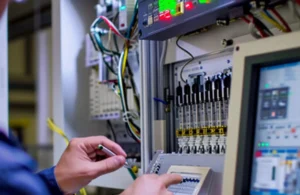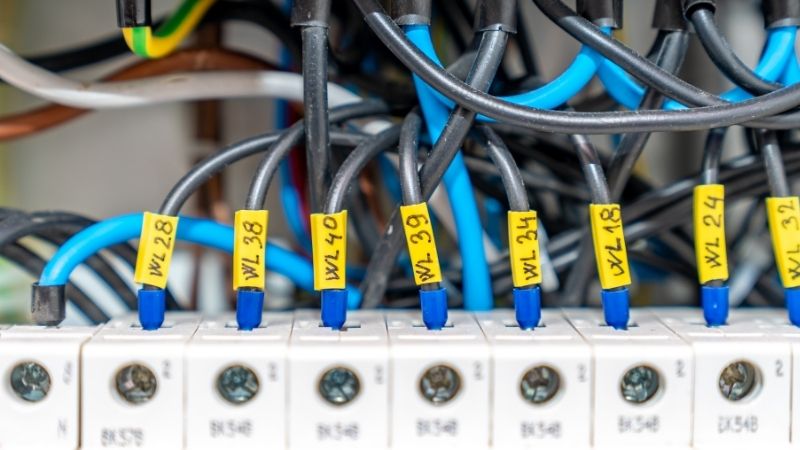SPS-Ausgabetypen: Grundlegender Leitfaden für Automatisierungsingenieure
Egal, ob Sie ein erfahrener Automatisierungsprofi sind oder gerade erst Ihre Reise beginnen, dieser Artikel bietet wertvolle Einblicke in SPS Ausgabetechnologien.
Inhaltsverzeichnis
Was sind die wichtigsten Arten von SPS-Ausgängen und wie funktionieren sie?
SPS-Ausgänge gibt es in verschiedenen Varianten, die jeweils für bestimmte Anwendungen und Anforderungen konzipiert sind. Die drei Haupttypen sind:
- Relaisausgänge: Traditionelle elektromechanische Schaltgeräte
- Transistorausgänge: Halbleiterschalter für Gleichstromanwendungen
- Triac-Ausgänge: Halbleiterschalter für AC-Anwendungen
Relaisausgänge sind am vielseitigsten, da sie sowohl Wechsel- als auch Gleichstromlasten verarbeiten können. Ein typisches Relaisausgangsmodul enthält physische Spulen und Relaiskontakte, die durch Anlegen einer Spannung an die Relaisspule betätigt werden. Beispielsweise kann das Allen-Bradley 1756-OW16I verfügt über 16 einzelne Relaisausgänge und ist daher für verschiedene industrielle Anwendungen geeignet.
Was sind die Hauptunterschiede zwischen Halbleiter- und Relaisausgängen?
Die Wahl zwischen Halbleiter- und Relaisausgängen hängt von mehreren Faktoren ab:
| Besonderheit | Halbleiterausgänge | Relaisausgänge |
|---|---|---|
| Schaltgeschwindigkeit | Schnell (Mikrosekunden) | Langsam (Millisekunden) |
| Lebensdauer | Lang (keine beweglichen Teile) | Begrenzt (mechanischer Verschleiß) |
| Spannungsbereich | Beschränkt auf Wechsel- oder Gleichstrom | Sowohl AC als auch DC |
| Kosten | Höhere Anschaffungskosten | Niedrigere Anschaffungskosten |
| Wartung | Minimal | Regelmäßige Wartung erforderlich |
Ein Vorteil von Relaisausgängen ist ihre Spannungsunabhängigkeit, sodass sie sowohl Wechsel- als auch Gleichstromlasten schalten können, ohne dass separate Module erforderlich sind. Halbleitergeräte bieten jedoch aufgrund des Fehlens beweglicher Teile eine höhere Zuverlässigkeit und längere Lebensdauer.
Wie erfolgt die Schnittstelle digitaler Ausgabemodule zu Industrieanlagen?
Digitale Ausgangsmodule dienen als Schnittstelle zwischen dem SPS-Programm und externen Geräten. Diese Module können Folgendes steuern:
- Motorstarter
- Magnetventile
- Kontrollleuchten
- Schütze
- Andere digitale oder diskrete Geräte
Das Ausgangsmodul arbeitet auf der Grundlage von Entscheidungen des SPS-Programms und wandelt diese Entscheidungen über Spannungs- oder Stromsignale in physikalische Aktionen um. Sie können beispielsweise einen Ausgang zum Betreiben einer Wechselstromlast und einen anderen Ausgang zum Steuern einer Gleichstromlast verwenden, was flexible Steuerungsoptionen bietet.
Was muss bei der Auswahl des SPS-Ausgangs berücksichtigt werden?
Berücksichtigen Sie bei der Auswahl von SPS-Ausgängen diese wichtigen Faktoren:
- Nennspannung und Nennstrom
- Betriebsspannungsanforderungen
- Maximale Stromaufnahme
- Überspannungsschutzbedarf
- Switching-Anforderungen
- Schalthäufigkeit
- Lasttyp (ohmsch, induktiv, kapazitiv)
- Anforderungen an die Reaktionszeit
- Umgebungsbedingungen
- Betriebstemperatur
- Luftfeuchtigkeit
- Elektrisches Rauschen
Welche Probleme treten häufig bei der Fehlerbehebung bei SPS-Ausgängen auf?
Das Verstehen häufiger Ausgabeprobleme trägt dazu bei, die Systemzuverlässigkeit aufrechtzuerhalten:
- Kurzschlussschutz der Ausgänge
- Spannungsabfälle über große Entfernungen
- Störungen durch Geräte in der Nähe
- Symptome eines Ausgabemodulfehlers
- Richtige Erdungstechniken
Häufig gestellte Fragen
Ein SPS-Ausgabemodul wandelt Programmentscheidungen in physische Aktionen um, indem es externe Geräte über elektrische Signale steuert.
Die Wahl hängt von Ihren Lastanforderungen und dem Systemdesign ab. Senkende Ausgänge sind in Nordamerika üblich, während quellende Ausgänge in Europa vorherrschen.
Transistorausgänge bieten schnellere Schaltgeschwindigkeiten, eine längere Lebensdauer und keinen mechanischen Verschleiß, was sie ideal für Hochgeschwindigkeitsanwendungen macht.
Relaisausgänge werden bevorzugt, wenn Spannungsflexibilität erforderlich ist oder eine vollständige elektrische Trennung zwischen Steuer- und Lastkreisen erforderlich ist.
Verwenden Sie einen geeigneten Überspannungsschutz, stellen Sie die richtige Verkabelung sicher, halten Sie die richtigen Belastungswerte ein und ergreifen Sie angemessene Kühlmaßnahmen.
Versorgen Sie Ihre Projekte mit brandneuen, originalen SPS von Omron, Mitsubishi und Schneider – auf Lager, sofort verfügbar!
Abschluss
- Es gibt drei Haupttypen von SPS-Ausgängen: Relais, Transistor und Triac.
- Jeder Ausgabetyp hat spezifische Vorteile und Anwendungen
- Die richtige Auswahl hängt von den Lastanforderungen und den Umgebungsbedingungen ab
- Regelmäßige Wartung und Überwachung sichern zuverlässigen Betrieb
- Schutzmaßnahmen sind für die langfristige Zuverlässigkeit unerlässlich
Suchen Sie nach neuen, originalen SPS für Ihre Projekte? Bei Kwoco führen wir die neuesten SPS von Top-Marken wie Omron, Mitsubishi, Und Schneider. Kaufen Sie vertrauensvoll ein – schneller Versand, garantierte Qualität! Jetzt kaufen
Kontaktieren Sie uns
Geben Sie in dieses Formular einfach Ihren Namen, Ihre E-Mail-Adresse und eine kurze Beschreibung Ihrer Anfrage ein. Wir werden Sie innerhalb von 24 Stunden kontaktieren.
Diese Themen könnten Sie auch interessieren

10 wichtige Erkenntnisse zur OMRON PLC CJ2-Serie
10 wesentliche Erkenntnisse über OMRON PLC CJ2 Serie KWOCO konzentriert sich auf international renommierte industrielle Automatisierungsprodukte, ich habe umfangreiche praktische

Ethernet vs. Modbus: Welches ist für Ihre Fabrik die beste Lösung?
Stellen Sie sich vor, Sie sind Einkaufsleiter und müssen ein Kommunikationsprotokoll auswählen, um verschiedene Geräte in Ihrer Produktionslinie zu verbinden. Wenn Sie das falsche Protokoll wählen, kann sich das Projekt verzögern und die Produktqualität beeinträchtigen. Welches Protokoll ist also besser für Ihre Anforderungen geeignet: Ethernet oder Modbus?

SLC500- und ControlLogix-SPS beherrschen: Ein umfassender Leitfaden
Die industrielle Automatisierung hat die Fertigung revolutioniert, und im Mittelpunkt dieser Revolution stehen speicherprogrammierbare Steuerungen (SPS). Zu den bekanntesten zählen die Serien SLC 500 und ControlLogix von Rockwell Automation. In diesem umfassenden Handbuch erfahren Sie mehr über diese Steuerungen und erfahren, welche Funktionen und Anwendungen sie bieten und wie sie Ihre Automatisierungsprozesse verbessern können.






